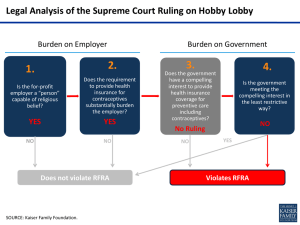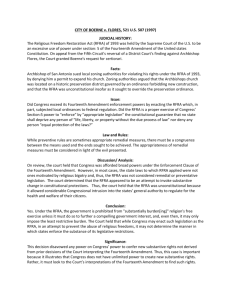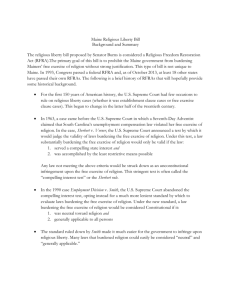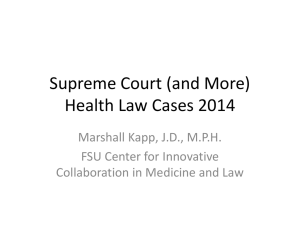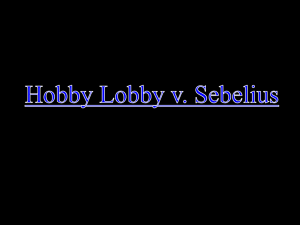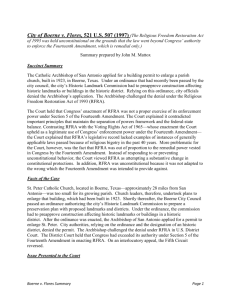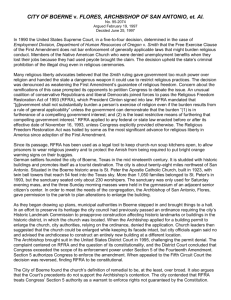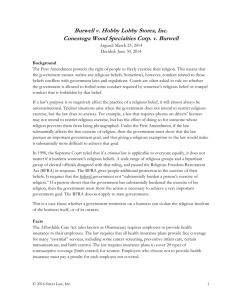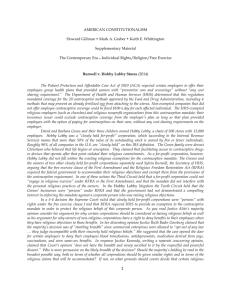Brief - The Becket Fund for Religious Liberty
advertisement
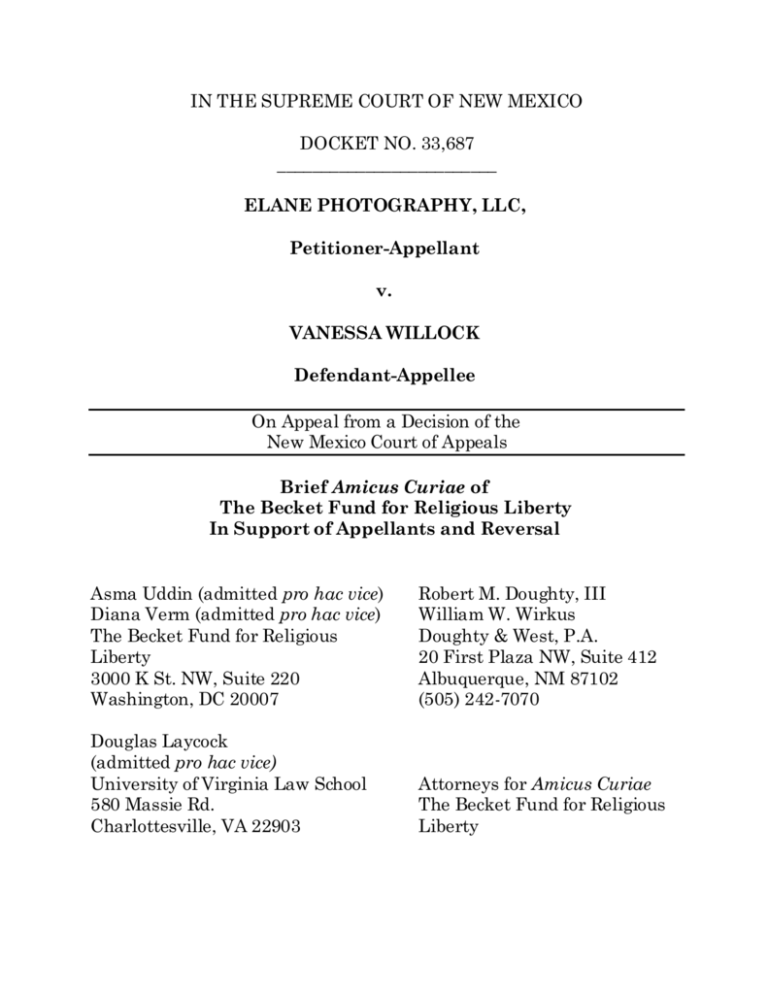
IN THE SUPREME COURT OF NEW MEXICO DOCKET NO. 33,687 _________________________ ELANE PHOTOGRAPHY, LLC, Petitioner-Appellant v. VANESSA WILLOCK Defendant-Appellee On Appeal from a Decision of the New Mexico Court of Appeals Brief Amicus Curiae of The Becket Fund for Religious Liberty In Support of Appellants and Reversal Asma Uddin (admitted pro hac vice) Diana Verm (admitted pro hac vice) The Becket Fund for Religious Liberty 3000 K St. NW, Suite 220 Washington, DC 20007 Robert M. Doughty, III William W. Wirkus Doughty & West, P.A. 20 First Plaza NW, Suite 412 Albuquerque, NM 87102 (505) 242-7070 Douglas Laycock (admitted pro hac vice) University of Virginia Law School 580 Massie Rd. Charlottesville, VA 22903 Attorneys for Amicus Curiae The Becket Fund for Religious Liberty TABLE OF CONTENTS TABLE OF AUTHORITIES ........................................................................ iii CERTIFICATION .......................................................................................... 1 INTRODUCTION .......................................................................................... 1 ARGUMENT .................................................................................................. 2 I. The court of appeals erred by confining NMRFRA to suits involving a government party. ................................................................ 2 A. Confining NMRFRA to suits involving a government party would contravene existing precedent. ................................ 3 B. The United States government has taken the position that RFRA applies to suits between private parties. ................ 12 C. Confining NMRFRA to suits involving a government party would contravene NMRFRA‘s text.................................... 14 D. Confining NMRFRA to suits involving a government party would contravene its legislative history........................... 24 E. Confining NMRFRA to suits involving a government party would contravene NMRFRA‘s purpose............................. 29 F. Confining NMRFRA to suits involving a government party would produce anomalous results. .................................... 34 CONCLUSION............................................................................................. 36 ii TABLE OF AUTHORITIES CASES PAGE(S) Atascadero State Hosp. v. Scanlon, 473 U.S. 234 (1985).................................................................................. 20 Barr v. City of Sinton, 295 S.W.3d 287 (Tex. 2009) ...................................................................... 6 Boggan v. Miss. Conference of the United Methodist Church, 222 Fed. App‘x 352 (5th Cir. 2007) ........................................................ 13 Catholic High Sch. Ass'n of Archdiocese of N.Y. v. Culvert, 753 F.2d 1161 (2d Cir. 1985)................................................................... 27 Celnik v. Congregation B'Nai Israel, 139 N.M. 252 (2006)........................................................................... 32, 33 City of Boerne v. Flores, 521 U.S. 507 (1997).............................................................................. 3, 30 Cockrell v. Bd. of Regents of N.M. State Univ., 132 N.M. 156 (2002)................................................................................. 21 Dolter v. Wahlert High Sch., 483 F. Supp. 266 (N.D. Iowa 1980) ........................................................ 27 EEOC v. Catholic Univ. of Am., 83 F.3d 455 (D.C. Cir. 1996) ............................................................... 8, 36 Employment Div. v. Smith, 494 U.S. 872 (1990).................................................................................. 30 Friedlander v. Port Jewish Ctr., No. 09-0021-cv, 2009 WL 3109870 (2d Cir. 2009) ................................ 32 Gay Rights Coalition of Georgetown Univ. Law Ctr. v. Georgetown Univ., 536 A.2d 1 (D.C. Cir. 1987) ..................................................................... 27 iii General Conference of Seventh-day Adventists v. McGill, 617 F.3d 402 (6th Cir. 2010) ......................................................... 9, 10, 19 Hankins v. Lyght, 441 F.3d 96 (2d Cir. 2006)................................................................... 7, 35 Hosanna-Tabor Evangelical Lutheran Church and Sch. v. EEOC, 132 S. Ct. 694 (2012).......................................................................... 23, 32 Hutchison v. Luddy, 606 A.2d 905 (Pa. Super. Ct. 1992) ........................................................ 27 In Re Episcopal Church, 76 Va. Cir. 873 (Va. Cir. 2008) ................................................................. 6 In re Young, 82 F.3d 1407 (8th Cir. 1996) .......................................................... 7, 8, 22, Jones v. Wolf, 443 U.S. 595 (1979)............................................................................ 23, 34 Latin Am. Council of Christian Churches v. Leal, 57 N.M. 502 (1953)................................................................................... 33 Lukaszewski v. Nazareth Hosp., 764 F. Supp. 57 (E.D. Penn. 1991) ......................................................... 27 McClure v. Salvation Army, 460 F.2d 553 (5th Cir. 1972) ............................................................. 23, 33 Miller v. Catholic Diocese of Great Falls, Billings, 728 P.2d 794 (1986) ........................................................................... 27, 28 N.Y. Times v. Sullivan, 376 U.S. 254 (1964)............................................................................ 23, 24 Petruska v. Gannon Univ., 462 F.3d 294 (3d Cir. 2006)..................................................................... 32 Rweyemamu v. Cote, 520 F.3d 198 (2d Cir. 2008)..................................................................... 10 iv Scharon v. St. Luke’s Episcopal Presbyterian Hosps, 929 F.2d 360 (8th Cir. 1991) ................................................................... 32 Serbian E. Orthodox Diocese v. Milivojevich, 426 U.S. 696 (1976)............................................................................ 23, 34 Shaliehsabou v. Hebrew Home of Greater Washington, 363 F.3d 299 (4th Cir. 2004) ................................................................... 32 Sossamon v. Texas, 131 S. Ct. 1651 (2011).............................................................................. 21 State v. Davis, 134 N.M. 172 (2003)........................................................................... 25, 35 Sutton v. Providence St. Joseph Medical Ctr., 192 F.3d 826 (9th Cir. 1999) ............................................................. 10, 11 Tomic v. Catholic Diocese of Peoria, 442 F.3d 1036 (7th Cir. 2006) ................................................................. 12 U.S. v. Lee, 455 U.S. 252 (1982).................................................................................. 24 Watson v. Jones, 80 U.S. 679 (1871)........................................................................ 23, 33, 34 Wheaton Coll. v. Sebelius, No. 20-1169 (D.D.C. Aug. 24, 2012) ................................................. 13, 14 Williamson v. Mazda Motor of Am., Inc., 131 S. Ct. 1131 (2011).............................................................................. 14 Worldwide Church of God v. Philadelphia Church of God, Inc., 227 F.3d 1110 (9th Cir. 2000) ................................................................. 11 STATUTES Human Rights Act, NMSA 1978 §28-1-12......................................................................... 10, 35 v Human Rights Act, NMSA 1978, § 28-1-13............................................................................. 35 Human Rights Act, NMSA 1978, § 28-1-7............................................................................... 36 Human Rights Act, NMSA 1978, §28-1-10........................................................................ 10, 35 New Mexico Religious Freedom Restoration Act, NMSA 1978, § 28-22-2............................................................................. 22 New Mexico Religious Freedom Restoration Act, NMSA 1978, § 28-22-3............................................................... 2, 5, 19, 24 New Mexico Religious Freedom Restoration Act, NMSA 1978, § 28-22-4........................................................ 2, 5, 15, 18, 26 New Mexico Religious Freedom Restoration Act, NMSA 1978, § 28-22-5......................................................................... 3, 31 Religious Freedom Restoration Act, 42 U.S.C. § 2000bb ................................................................................... 30 Religious Freedom Restoration Act, 42 U.S.C. § 2000bb-1 ...............................................................5, 15, 19, 26 Religious Freedom Restoration Act, H.R. 2797, 102d Cong. § 3(c) (1991) ....................................................... 26 Religious Freedom Restoration Act, S. 3254, 101st Cong. § 2(c) (1990) .......................................................... 25 OTHER AUTHORITIES 106 Cong. Rec. 16216 (1999)....................................................................... 29 Black‘s Law Dictionary (8th Ed.) ............................................................... 17 vi Christopher Lund, Religious Liberty After Gonzales: A Look at State RFRAs, 55 S.D. L. Rev. 466 (2010)....................................................................... 31 David Ackerman, Congressional Research Service, Library of Congress, The Religious Freedom Restoration Act and the Religious Freedom Act: A Legal Analysis (1992) .................................. 27 Eugene Volokh, Tort Liability and the Original Meaning of the Freedom of Speech, Press, and Petition, 96 Iowa L. Rev. 249 (2010)...................................................................... 24 H.R. Rep. No. 103-88 (1993) ................................................................. 27, 28 Religious Freedom Restoration Act of 1991: Hearings Before the Subcommittee on Civil and Constitutional Rights, 101st Cong. (1991) ................................................................................... 27 S. Rep. No. 103-111 (1993).......................................................................... 28 Shruti Chaganti, Why the Religious Freedom Restoration Act Provides a Defense in Suits by Private Plaintiffs, 99 Va. L. Rev. ---- (forthcoming 2013)..................................25, 28, 29, 37 vii CERTIFICATION Pursuant to NMRA 12-215, counsel for amicus curiae has provided timely notice to all parties of its intent to file this brief. INTRODUCTION This case turns on the interpretation of the New Mexico Religious Freedom Restoration Act (NMRFRA). The appellate court below summarily dismissed the argument that NMRFRA is applicable in this case because no government entity is a party to the lawsuit. The appellate court‘s reading of the statute, however, failed to take into account the full meaning of the text, history, and purpose of NMRFRA, all of which compel the conclusion that the statute applies in all cases in which a law substantially burdens religious exercise. NMRFRA is the state analogue of the federal RFRA, which was enacted by Congress to provide free exercise protections stronger than that provided by contemporary constitutional jurisprudence. Religious individuals thus rely on NMRFRA for protections not otherwise provided by the Constitution. NMRFRA reads, in part: ―A person whose free exercise of religion has been restricted by a violation of the New Mexico Religious Freedom 1 Restoration Act may assert that violation as a claim or defense in a judicial proceeding and obtain appropriate relief against a government agency, …‖ NMSA 1978, § 28-22-4 (emphasis added). This brief provides a comprehensive analysis of the text, legislative history, and drafting history of NMRFRA. This analysis demonstrates that the phrase ―obtain appropriate relief against a government agency‖ does not limit the relief provided under NMRFRA, but broadens it. This conclusion is in line with the majority of federal circuit courts and the position of the United States government, but most importantly it is supported by NMRFRA‘s purpose, which is to alleviate burdens placed by the government on religious exercise. It would be contrary to the text, history, and purpose of NMRFRA to fail to apply it in this case. ARGUMENT I. The court of appeals erred by confining NMRFRA to suits involving a government party. The New Mexico Religious Freedom Restoration Act (―NMRFRA‖) prohibits a government agency from restricting a person‘s free exercise of religion except in narrowly defined circumstances. NMSA 1978, § 2822-3. According to its text, it is designed to provide ―addition[al]‖ protection for religious exercise, above and beyond ―the protections 2 granted by federal law and the state and federal constitutions.‖ NMSA 1978, § 28-22-5. Contrary to this text, the court of appeals interpreted NMRFRA to provide less protection than the state and federal constitutions, by concluding that ―NMRFRA is applicable only in cases that involve a government agency as an adverse party in the litigation.‖ Op. 17. That conclusion was incorrect. It contradicts the holdings of most of the United States Courts of Appeals with respect to the federal RFRA; it contradicts the text, history, and purpose of NMRFRA; and it produces anomalous results. This conclusion is confirmed by new research into the legislative history of the disputed language—research that goes far beyond the evidence considered by any previous court. The court of appeals should be reversed. A. Confining NMRFRA to suits involving a government party would contravene existing precedent. Like many state RFRAs, NMRFRA is modeled on the federal RFRA. It was enacted in 2000, shortly after the Supreme Court‘s ruling in City of Boerne v. Flores, 521 U.S. 507 (1997), which struck down the application of federal RFRA to the states. As shown in the following chart, the relevant provisions of NMRFRA follow the federal RFRA 3 almost verbatim: Federal RFRA 42 U.S.C. § 2000bb-1(b) NMRFRA NMSA 1978, § 28-22-3 Government may substantially burden a person's exercise of religion only if it demonstrates that A government agency shall not restrict a person‘s free exercise of religion unless: . . . application of the burden to the person-- the application of the restriction to the person (1) is in furtherance of a compelling governmental interest; and is essential to further a compelling governmental interest and (2) is the least restrictive means of furthering that compelling governmental interest. 42 U.S.C. § 2000bb-1(c) is the least restrictive means of furthering that compelling governmental interest. NMSA 1978, § 28-22-4 A person whose religious exercise has been burdened in violation of this section A person whose free exercise of religion has been restricted by a violation of the New Mexico Religious Freedom Restoration Act may assert that violation as a claim or defense in a judicial proceeding and obtain appropriate relief against a government. may assert that violation as a claim or defense in a judicial proceeding and obtain appropriate relief against a government agency, including: (1) injunctive or declaratory relief against a government agency that violates or proposes to violate the provisions of the New Mexico Religious Freedom Restoration Act; and (2) damages pursuant to the Tort Claims Act, reasonable attorney fees and costs. 4 Other state courts, recognizing the textual link between their state RFRAs and the federal RFRA, have held that federal courts‘ interpretation of the federal RFRA is persuasive authority in interpreting their state RFRAs. See, e.g., In Re Episcopal Church, 76 Va. Cir. 873, 875 (Va. Cir. 2008) (explaining that ―the manner in which the Religious Freedom Restoration Act (―RFRA‖) has been interpreted lends abundant support to this Court's [interpretation of Virginia‘s state RFRA]‖ because the language of the statutes is ―substantially similar‖); Barr v. City of Sinton, 295 S.W.3d 287, 296 (Tex. 2009) (―Because TRFRA, RFRA, and RLUIPA were all enacted in response to Smith and were animated in their common history, language, and purpose by the same spirit of protection of religious freedom, we will consider decisions applying the federal statutes germane in applying the Texas statute.‖). Here, the court of appeals rightly looked to federal precedent in interpreting NMRFRA (Op. 17-18); but it chose the wrong side of a lopsided circuit split. Contrary to the decision below, most federal courts of appeals to consider the question have held that RFRA can provide a defense in suits between private parties. The leading case is 5 Hankins v. Lyght, 441 F.3d 96 (2d Cir. 2006). There, a minister sued his church for age discrimination under the Age Discrimination in Employment Act (ADEA). The church asserted RFRA as a defense. The question was whether RFRA applied to suits between private parties. The Second Circuit held that RFRA‘s text ―easily covers‖ suits between private parties. Id. at 103. Specifically, it noted that RFRA, by its text, applies to ―all federal law, and the implementation of that law,‖ and that RFRA allows a party to assert RFRA ―as a . . . defense in a judicial proceeding.‖ Id. at 103 (quoting 42 U.S.C. §§ 2000bb-3(a), 2000bb-1(c)). The ―only conceivably narrowing language‖ in RFRA was the phrase that allowed a litigant to ―obtain appropriate relief against a government.‖ Id. But this language, the court held, is ―most reasonably read as broadening, rather than narrowing, the rights of a party asserting the RFRA,‖ because it makes clear that RFRA also provides relief against a government. Id. Thus, court held that RFRA applies to suits between private parties. Id. The Eighth Circuit reached the same conclusion in In re Young, 82 F.3d 1407, 1416-1417 (8th Cir. 1996), vacated, 521 U.S. 1114 (1997), reinstated, 141 F.3d 854 (8th Cir.), cert. denied, 525 U.S. 811 (1998). 6 There, a bankruptcy trustee filed a claim under the bankruptcy code against a church, seeking to force the church to return charitable contributions that the debtors had made to the church before filing for bankruptcy. In other words, the case involved one private party seeking to recover money from another. The church, however, argued that requiring it to return the contributions would violate RFRA. The Eighth Circuit agreed. The court based its holding on RFRA‘s broad definition of ―government,‖ which ―include[s] ‗a branch, department, agency, instrumentality, and official.‘‖ Id. at 1416. (quoting statute). As the court explained: ―The bankruptcy code is federal law, the federal courts are a branch of the United States, and [the court‘s] decision in the present case would involve the implementation of federal bankruptcy law.‖ Id. at 1416-17. Thus, even though the case was a suit between private parties, the burden was ultimately imposed by the ―government.‖ Id. Like the Second and Eighth Circuits, the D.C. Circuit has held that RFRA can serve as a defense in suits between private parties. In EEOC v. Catholic University of America, 83 F.3d 455 (D.C. Cir. 1996), the court considered two separate employment-discrimination lawsuits 7 brought by two different parties—one brought by a private plaintiff and one brought by the EEOC. The court applied RFRA to bar both suits, thus applying RFRA to a suit between private parties. Id. The Sixth Circuit disagreed in part, but not in a way that would support the decision below. The most recent example is General Conference of Seventh-day Adventists v. McGill, 617 F.3d 402 (6th Cir. 2010). There, one private party sued another for a violation of federal copyright law. Invoking the dissent in Hankins, the court focused on RFRA‘s use of the term ―government.‖ Id. at 410-12. Specifically, it noted that RFRA‘s text provides that a party whose religious exercise has been burdened can ―assert [a RFRA] violation as a claim or defense in a judicial proceeding and obtain appropriate relief against a government.‖ Id. at 410 (emphasis added). RFRA also requires that the ―government‖ demonstrate that the burden on religious exercise was the least restrictive means of furthering a compelling governmental interest. Id. Based on these two references to the ―government,‖ the Sixth Circuit held that RFRA did not apply to a copyright suit between two private parties. Id. at 412. 8 But the court explicitly distinguished cases like this one, where the law can be enforced either by a private plaintiff or by a government agency. It was essential to the court‘s holding that copyright law can be enforced only by private entities—whereas other statutes, like the employment discrimination law in Hankins, could also be enforced by government agencies like the EEOC. Id. at 411. The court conceded the practical implications of the Hankins holding, stating that with respect to these statutes, allowing a RFRA defense when a private plaintiff sues is necessary ―to avoid disparate application of [RFRA] based on who brings discrimination charges.‖ Id. That view of the matter is fully applicable here, where the law can be enforced by a private plaintiff, NMSA 1978, §28-1-10(J), or by the Commission, §28-1-10(H), or by the Attorney General, §28-1-12.1 In Sutton v. Providence St. Joseph Medical Center, 192 F.3d 826 (9th Cir. 1999), the Ninth Circuit took an entirely different approach. It held that RFRA would apply to suits between private parties where one of the parties was ―acting under color of law.‖ Id. at 834. There, the See also Rweyemamu v. Cote, 520 F.3d 198, 203 (2d Cir. 2008) (expressing doubts about Hankins, but not in cases where either a private plaintiff or government agency could sue). 9 1 plaintiff filed a RFRA suit against a private company that refused to hire him because he refused, on religious grounds, to record his social security number in an employment form. Id. at 829-30. According to the Ninth Circuit, the resolution of the case turned on RFRA‘s definition of ―government,‖ which included any person ―acting under color of law.‖ Id. at 834. Although the court concluded that the private defendant had not violated RFRA because the plaintiff had not alleged the necessary ―nexus between the private entity and the government,‖ id. at 838, it left open the possibility that RFRA would apply when the party asserting RFRA demonstrated the required nexus between a private party and the government. Id. at 841.2 This was not a case in which a private plaintiff sued to enforce a law that allegedly made defendant‘s religiously motivated behavior illegal. It was not a case in which the court, which is an indisputable part of government, was the final instrument by which the burden on religious exercise was imposed. This was the more difficult case of a religious In Worldwide Church of God v. Philadelphia Church of God, Inc., the Ninth Circuit briefly discussed RFRA‘s application to private suits. 227 F.3d 1110 (9th Cir. 2000). The court noted only that RFRA‘s application to copyright law was an ―open question‖ that the court ―need not decide.‖ Id. at 1121. 10 2 plaintiff suing a secular employer, and it was argued on the mistaken theory that every person who complies with the law thereby becomes a state actor. We do not claim that Willock is the government. Rather, we claim that the burden on Elane Photography‘s religious exercise is imposed by government—by the statute that imposes the alleged liability, by the New Mexico Human Rights Commission, and ultimately by the court if it enforces the order of the Commission. Only the Seventh Circuit has suggested that a RFRA defense is unavailable even in cases where a government agency could have been the plaintiff, and that was little more than a passing comment in Tomic v. Catholic Diocese of Peoria, 442 F.3d 1036 (7th Cir. 2006). There was no RFRA issue presented in Tomic; the court commented sua sponte to reject the Second Circuit‘s then recent suggestion that RFRA preempted the constitutionally based ―ministerial exception.‖ On that issue, the Seventh Circuit thought it dispositive that RFRA was intended to expand protection for religious liberty, not contract it; RFRA could not have been intended to repeal the ministerial exception. The court also said, without a single word of briefing, that ―RFRA is applicable only to 11 suits to which the government is a party.‖ Id. at 1042. This uninformed dictum is entitled to little weight. See also Boggan v. Miss. Conference of the United Methodist Church, 222 Fed. App‘x 352 (5th Cir. 2007) (unpublished) (also holding that RFRA does not preempt the ministerial exception.) In sum, the Second, Eighth, and D.C. Circuits have squarely held that a RFRA defense is available in suits by private plaintiffs. The Sixth Circuit agrees in cases like this one, where a government agency could be the plaintiff. The Ninth Circuit has left the issue open while taking a somewhat different route to the problem. Only an illconsidered dictum in the Seventh Circuit goes the other way. B. The United States government has taken the position that RFRA applies to suits between private parties. The United States Department of Justice has recently joined the majority of circuits in concluding that RFRA applies to suits between private parties. The United States currently faces over thirty RFRA lawsuits challenging a controversial regulation that would force religious organizations to provide insurance coverage for certain drugs in violation of their religious beliefs. See Wheaton Coll. v. Sebelius, No. 20-1169, slip op. at 2 (D.D.C. Aug. 24, 2012) (citing The Becket Fund for 12 Religious Liberty, HHS Information Central www.becketfund.org/ hhsinformationcentral (listing thirty-seven cases against the department of Health and Human Services)). The United States has sought to dismiss those lawsuits as unripe; but the religious organizations have argued that they currently face the threat of private lawsuits for violating the federal regulations. Id. at 9. In response, the United States has formally taken the position that religious organizations can assert RFRA as a defense in lawsuits brought by private parties: ―[I]f plaintiff were sued by a plan participant or beneficiary in the future, plaintiff, in its defense of such an action, would have an opportunity to raise its contention that the contraceptive coverage requirement violates the Religious Freedom Restoration Act (―RFRA‖).‖ Reply in Support of Motion to Dismiss at 3-4, Wheaton Coll. v. Sebelius, No. 12-01169 (D.D.C. Aug. 20, 2012). This interpretation of RFRA by the United States government is entitled to significant weight. See, e.g., Williamson v. Mazda Motor of Am., Inc., 131 S. Ct. 1131, 1137 (2011) (relying on the Department of Justice‘s interpretation of a federal law in an amicus brief). * * * 13 * * As explained below, the court of appeals erred by rejecting the position of the United States and the majority of circuits. Confining RFRA (or NMRFRA) to suits between private parties is inconsistent with the statute‘s text, history, and purpose, and it also produces anomalous results. C. Confining NMRFRA to suits involving a government party would contravene NMRFRA’s text NMRFRA states in relevant part: A person whose free exercise of religion has been restricted by a violation of the [NMRFRA] may assert that violation as a claim or defense in a judicial proceeding and obtain appropriate relief against a government agency . . . . NMSA 1978, § 28-22-4 (emphasis added). This language is virtually identical to the federal RFRA, which provides: A person whose religious exercise has been burdened in violation of [the federal RFRA] may assert that violation as a claim or defense in a judicial proceeding and obtain appropriate relief against a government. 42 U.S.C. § 2000bb-1(c) (emphasis added). The key question, and the one giving rise to the circuit split, is whether the phrase ―obtain appropriate relief against a government [agency]‖ narrows the statute by limiting it to suits against a government agency, or instead broadens the statute by attempting to 14 abrogate sovereign immunity and by explicitly authorizing relief against the government. The court below adopted the narrowing interpretation. But there are two textual problems with that approach. First, the narrowing interpretation incorrectly assumes that ―against a government‖ is a misplaced modifier. As written, the statute includes two different verbs allowing ―a person‖ to do two different things: (1) ―assert [a] violation [of NMRFA] as a claim or defense in a judicial proceeding‖ and (2) ―obtain appropriate relief against a government.‖ The phrase ―against a government‖ modifies only the latter. But the narrowing interpretation assumes that it modifies the former instead. Thus, it re-writes the statute to read: A person whose free exercise of religion has been restricted by a violation of the [NMRFRA] may assert that violation as a claim or defense in a judicial proceeding against a government agency and obtain appropriate relief against a government agency. This re-writing would, indeed, limit NMRFRA to ―a judicial proceeding against a government agency‖; but it is not what the statute says. Second, the narrowing interpretation incorrectly assumes that ―appropriate relief against a government agency‖ describes what 15 happens when NMRFRA is asserted as ―a claim or defense.‖ But that interpretation does violence to the meaning of the words ―claim,‖ ―defense,‖ and ―relief.‖ Specifically, when a litigant asserts NMRFRA as a defense, she is ineligible to receive any relief at all—whether an injunction, declaration, damages, or attorneys‘ fees. A defense merely defeats liability. Only when a litigant asserts a claim can she obtain relief. See Black‘s Law Dictionary 1317 (8th ed.) (defining ―relief‖ as ―[t]he redress or benefit, esp. equitable in nature (such as an injunction or specific performance), that a party asks of a court. – Also termed remedy‖); id. at 264 (stating that ―claim for relief‖ is a synonym for ―claim‖). Thus, it makes no sense to view ―obtain appropriate relief against a government‖ as describing the result of ―a claim or defense.‖ It must describe only the result of a ―claim‖ (in which case the grammatical construction of the sentence makes no sense), or it must describe neither. Correctly interpreted, it describes neither. Rather than modifying ―a claim or defense in a judicial proceeding,‖ the phrase ―obtain appropriate relief against a government‖ clarifies an additional function of the statute: namely, to provide relief against a government. 16 In other words, NMRFRA cannot only be asserted ―as a claim or defense in a judicial proceeding‖ but also can be the basis for obtaining ―appropriate relief against a government agency.‖ This interpretation is confirmed by two key differences between NMRFRA and the federal RFRA. First, unlike the federal RFRA, NMRFRA goes on to specify precisely what relief is available against a government agency: namely, ―(1) injunctive or declaratory relief against a government agency that violates or proposes to violate the provisions of the New Mexico Religious Freedom Restoration Act; and (2) damages pursuant to the Tort Claims Act, reasonable attorney fees and costs.‖ NMSA 1978, § 28-22-4. Notably, neither form of relief is available as a ―defense in a judicial proceeding.‖ Id. This further demonstrates that the enumeration of the types of relief available against a government agency was not intended to modify the application of NMRFRA as a ―defense in a judicial proceeding,‖ but rather to explain an additional function of the statute. The second key difference is shown in the following chart: 17 Federal RFRA 42 U.S.C. § 2000bb-1(b) NMRFRA NMSA § 28-22-3 Government may substantially burden a person‘s exercise of religion only if it demonstrates that A government agency shall not restrict a person‘s free exercise of religion unless: . . . application of the burden to the person— the application of the restriction to the person (1) is in furtherance of a compelling governmental interest; and is essential to further a compelling governmental interest and (2) is the least restrictive means of is the least restrictive means of furthering that compelling furthering that compelling governmental interest. governmental interest. Under the federal RFRA, the ―[g]overnment‖ must ―demonstrate[]‖ that it satisfies strict scrutiny. 42 U.S.C. § 2000bb-1(b). The Sixth Circuit used this as additional evidence that the federal RFRA applies only when the government is a party. General Conference of Seventh-day Adventists, 617 F.3d at 410-11. This reasoning was mistaken; a private litigant seeking to enforce a government-imposed burden may undertake the government‘s burden of justification or not, as she chooses. But in any event, NMRFRA does not include this statement. Rather, it uses the passive voice—leaving room for cases in which a 18 party other than the government will be required to justify the burden on religion that that private party seeks to enforce. In sum, when NMRFRA provides that it may be asserted as a ―claim or defense in a judicial proceeding,‖ and that a litigant may ―obtain appropriate relief against a government agency,‖ it is describing two aspects of the statute: its general use as a claim or defense in a judicial proceeding, and its specific ability to provide appropriate relief against a government agency. Why would the statute use this sort of dual construction? The answer is simple: sovereign immunity and the confusion associated with changes in the Supreme Court‘s doctrine concerning sovereign immunity—doctrine that was in flux when Congress considered RFRA. Supreme Court precedent allowed Congress to abrogate sovereign immunity and apply RFRA to the states—but only if Congress made its intention to do so ―unmistakably clear in the language of the statute.‖ Atascadero State Hosp. v. Scanlon, 473 U.S. 234, 242 (1985). Thus, if Congress wanted religious adherents to be able to rely on RFRA in suits against states or state agencies, it was not enough to say that RFRA could be asserted ―as a claim or defense in a judicial proceeding‖; it also 19 had to say that RFRA could provide ―appropriate relief against a government.‖ The Supreme Court ultimately held that this phrase was insufficient to override sovereign immunity. Sossamon v. Texas, 131 S. Ct. 1651 (2011). But the whole argument focused on the language authorizing ―appropriate relief against a government.‖ Petitioner and the dissenters relied on that language to override sovereign immunity; the majority also focused on that language but held it insufficient. See id. at 1658-60 (opinion of the Court); id. at 1664-68 (Sotomayor, J., dissenting). Sovereign immunity explains why that phrase was added to RFRA, why it was copied into the Religious Land Use and Institutionalized Persons Act at issue in Sossamon, and why it was copied into NMRFRA. See Cockrell v. Bd. of Regents of N.M. State Univ., 132 N.M. 156, 166 (2002) (―we require a clear and unambiguous expression of legislative intent to consent to suit‖). Finally, even assuming NMRFRA provides relief only against a ―government agency,‖ it does not follow that the government agency must be a party to the lawsuit. Under NMRFRA, ―government agency‖ is defined to include ―the state or any of its . . . commissions . . . or 20 authorities.‖ NMSA 1978, § 28-22-2. That clearly includes the New Mexico Human Rights Commission; it also includes state courts. Here, the statute, the Commission, and the courts, all agents of the government, are imposing a burden on Elane Photography. The Commission, backed by the authority of state courts, ―ordered Elane Photography to pay Willock $6,637.94 in attorney fees and costs.‖ Op. 3. Allowing Elane Photography to assert that burden as a ―defense in a judicial proceeding,‖ as NMRFRA says, would relieve that burden. This is just what the Eighth Circuit held in In re Young, 82 F.3d at 1416-1417, which involved a suit between private parties in bankruptcy. As the court explained: ―The bankruptcy code is federal law, the federal courts are a branch of the United States, and [the court‘s] decision in the present case would involve the implementation of federal bankruptcy law.‖ Id. at 1416-17. Thus, even though the case was a suit between private parties, the burden was ultimately imposed by the ―government.‖ Id. Courts have long applied the same understanding of ―state action‖ under the First Amendment. Although it has long been understood that the First Amendment limits only the government, not private parties, 21 the Supreme Court has repeatedly applied the First Amendment to suits between private parties—where the relevant government action was creation and enforcement of statutory or common law. For example, federal courts have long recognized the ―ministerial exception,‖ a rule under the Free Exercise and Establishment Clauses that bars employment discrimination lawsuits by ministers against religious organizations—suits by a private citizen against a private organization. McClure v. Salvation Army, 460 F.2d 553, 558 (5th Cir. 1972); Hosanna-Tabor Evangelical Lutheran Church and Sch. v. EEOC, 132 S. Ct. 694 (2012). A similar rule applies to many property disputes within religious organizations—which are also suits between wholly private parties. See, e.g., Jones v. Wolf, 443 U.S. 595 (1979); Serbian E. Orthodox Diocese v. Milivojevich, 426 U.S. 696 (1976); Watson v. Jones, 80 U.S. 679 (1871). All of these cases recognize that judicial enforcement of a law can impose a government burden on religious exercise—even when the suit is exclusively between private parties. The same is true under the Free Speech Clause. In New York Times v. Sullivan, for example, the Supreme Court held that the Free Speech Clause imposed restrictions on a libel suit between private parties. 376 22 U.S. 254 (1964). As the Court explained: ―Although this is a civil lawsuit between private parties, the Alabama courts have applied a state rule of law which petitioners claim to impose invalid restrictions on their constitutional freedoms of speech and press.‖ Id. at 265 (emphasis added). ―The test is not the form in which state power has been applied but, whatever the form, whether such power has in fact been exercised.‖ Id. This rule can be traced back to decisions in the founding era. Eugene Volokh, Tort Liability and the Original Meaning of the Freedom of Speech, Press, and Petition, 96 Iowa L. Rev. 249 (2010). The same is true here. It does not matter that ―this is a civil lawsuit between private parties‖; rather, the question is whether state power ―has in fact been exercised.‖ N.Y. Times, 376 U.S. at 265. By ordering Elane Photography to pay attorney fees and costs, the Human Rights Commission has ―restricted‖ Elane Photography‘s ―free exercise of religion,‖ and NMRFRA applies. NMSA 1978, § 28-22-3.3 Nor does it matter that Elane Photography is engaged in ―public commerce,‖ contrary to the appellate court‘s assertion. Op. 16. United States v. Lee, cited by the appellate court, actually holds that business owners have free exercise rights as applied to their businesses. U.S. v. Lee, 455 U.S. 252, 257 (1982) (―Because the payment of the taxes or receipt of benefits violates Amish religious beliefs, compulsory participation in the social security system interferes with their free 23 3 D. Confining NMRFRA to suits involving a government party would contravene its legislative history. This interpretation is not only grammatically superior and consistent with the doctrines of sovereign immunity and state action, but also supported by the legislative history of RFRA. ―The legislative history of the statute . . . is instructive when searching for the spirit and reason the Legislature utilized in enacting the statute.‖ State v. Davis, 134 N.M. 172, 175 (2003). The drafting history has been neglected in earlier decisions on this issue. It is reviewed in detail, and for the first time, in Shruti Chaganti, Why the Religious Freedom Restoration Act Provides a Defense in Suits by Private Plaintiffs, 99 Va. L. Rev. ---- (forthcoming 2013), available at http://papers.ssrn.com/sol3/papers.cfm? abstract_id=2155810. The original draft of RFRA proposed in the Senate in 1990 made clear that relief against the government was only one form of relief available under RFRA: ―A party aggrieved by a violation of this section may obtain appropriate relief (including relief against a government) in a civil action.‖ Religious Freedom Restoration Act, S. 3254, 101st Cong. exercise rights.‖). This point has been further addressed by Elane Photography and by other amici. 24 § 2(c) (1990). In this draft, it is clear that ―appropriate relief‖ is a more general category that ―includ[es] relief against a government,‖ and that the phrase ―(including relief against a government)‖ was intended to make sure that government defendants were included. As noted above, this was an attempt to override sovereign immunity. Ultimately, to clarify that RFRA could also be asserted as a defense, Congress deleted ―may obtain appropriate relief‖ and instead inserted ―may assert that violation as a claim or defense in a judicial proceeding.‖ See H.R. 2797, 102d Cong. § 3(c) (1991). But when it did that, the phrase ―(relief against a government)‖ no longer fit as a modifier of ―obtain appropriate relief.‖ Thus, it was added to the end of the sentence, where it would still convey the dual purposes of (1) allowing RFRA to be used as a claim or defense; and (2) allowing for relief against a government party. NMRFRA follows this structure. Compare 42 U.S.C. § 2000bb-1(c) with NMSA 1978, § 28-22-4(A). Other aspects of RFRA‘s legislative history confirm that it applies to suits between private parties. In particular, both the Committee reports and hearing testimonies confirm that Congress was concerned about all laws that burdened religion, whether or not they were enforced by a 25 government party. For example, the House Committee Report stated: ―[T]he definition of governmental activity covered by the bill is meant to be all inclusive. . . . [T]he test applies whenever a law or an action taken by the government to implement a law burdens a person‘s exercise of religion.‖ H.R. Rep. No. 103-88 (1993). More importantly, during the legislative hearings and debates, Congress considered several sources that highlighted the types of suits that would be affected by RFRA—and those reports specifically included suits between private parties.4 Relevant cases included employment lawsuits between a private religious employer and private employees;5 discrimination lawsuits between a private club and a private religious See Religious Freedom Restoration Act of 1991: Hearings Before the Subcommittee on Civil and Constitutional Rights, 101st Cong. 361-391 (1991) available at http://www.justice.gov/jmd/ls/legislative_histories/pl103-141/hear-991992.pdf (entered testimony of Douglas Laycock); David Ackerman, Congressional Research Service, Library of Congress, The Religious Freedom Restoration Act and the Religious Freedom Act: A Legal Analysis 14-17 (1992). 5 Miller v. Catholic Diocese of Great Falls, Billings, 728 P.2d 794 (1986) (tortious bad faith in employment); Lukaszewski v. Nazareth Hosp., 764 F. Supp. 57 (E.D. Penn. 1991) (Application of ADEA to religious hospital); Catholic High Sch. Ass'n of Archdiocese of N.Y. v. Culvert, 753 F.2d 1161 (2d Cir. 1985) (whether State Labor Relations Board had jurisdiction over relationship between parochial schools and lay teachers); Dolter v. Wahlert High Sch., 483 F. Supp. 266 (N.D. Iowa 1980) (sex discrimination under Title VII). 26 4 school;6 and discovery disputes between a private litigant and a private religious institution asserting privileges.7 These reports were referred to explicitly in the House and Senate committee reports. See H.R. Rep. No. 103-88, at 2 n.2; S. Rep. No. 103-111, at 5 n.3 (1993). Thus, Congress specifically contemplated that RFRA would apply to suits between private parties.8 The congressional debates over the Religious Liberty Protection Act (―RLPA‖) in 1999 are also informative. Like NMRFRA, the RLPA was proposed in 1999 as a response to Boerne. Although it did not ultimately pass, it generated significant debate that shed light on Congress‘s understanding of RFRA. See Chaganti, supra at 27. In particular, the key statutory language, which states that a person may assert a violation ―as a claim or defense in a judicial proceeding and obtain Gay Rights Coalition of Georgetown Univ. Law Ctr. v. Georgetown Univ., 536 A.2d 1 (D.C. Cir. 1987). 7 Hutchison v. Luddy, 606 A.2d 905 (Pa. Super. Ct. 1992). 8 Although legislative records are not available from the New Mexico legislature that passed NMRFRA, the similarities in language between the two statutes (see supra Part I.B.) indicate that the substantive record built up under the federal RFRA is relevant to NMRFRA as well. The federal legislative history is especially relevant here, where the issue is an ambiguity in statutory language, the New Mexico language was copied from the federal act, and the federal drafting history indicates how the ambiguity got into the statute. 27 6 appropriate relief against a government,‖ was included in the RLPA verbatim. Notwithstanding this language, every member of Congress participating in the debate assumed that RLPA would apply to suits between private parties. Indeed, the main point of contention over the RLPA involved the Nadler Amendment, which would have exempted private civil-rights plaintiffs from needing to satisfy the compelling interest test under RFRA. Chaganti, supra at 30. The parties vigorously debated the pros and cons of this amendment; but no party suggested that the amendment was unnecessary on the ground that RLPA applied only to suits against the government. For example, Representative Canady, Chair of the Judiciary Committee and a chief proponent of RLPA, argued that RLPA would provide needed protection in private employment discrimination lawsuits and private bankruptcy proceedings. 106 Cong. Rec. 16216, 16224 (1999) (Statement of Rep. Charles Canady); Chaganti, supra at 34. Representative Conyers opposed the RLPA precisely because it would provide a defense against ―individuals‖ who sued under fair housing or employment laws. 106 Cong. Rec. 16216, 16226 (1999) (Statement of Rep. John Conyers); 28 Chaganti, supra at 35. Nobody argued that the statute would apply only when the government was a party—despite language identical to RFRA and NMRFA. This history further confirms that Congress understood RFRA to apply to suits between private parties. E. Confining NMRFRA to suits involving a government party would contravene NMRFRA’s purpose. In addition to the text and legislative history, the underlying purpose of RFRA and NMRFRA demonstrate that they are not confined to suits involving a government party. The federal RFRA was enacted in 1993 in response to Employment Div. v. Smith, 494 U.S. 872 (1990). Prior to Smith, the government could burden a person‘s free exercise of religion only if it satisfied strict scrutiny; but in Smith, the Court cut back on the Free Exercise Clause, holding that satisfying strict scrutiny was unnecessary so long as the law at issue was neutral and generally applicable. Id. In response to public outcry over Smith, Congress enacted RFRA; it was designed to ―restore the compelling interest test‖ in ―all cases where free exercise of religion is substantially burdened,‖ thus providing more protection than the Free Exercise Clause alone. 42 U.S.C. § 2000bb(b)(1) (emphasis added). 29 NMRFRA (like other state RFRAs) has a similar purpose. In 1997, the Supreme Court struck down RFRA as applied to the states. Boerne, 521 U.S. 507. Thus, many state RFRAs, including NMRFRA, were enacted in response to Boerne; they were designed to restore the protection for religious freedom that existed under the federal RFRA before Boerne. See Christopher Lund, Religious Liberty After Gonzales: A Look at State RFRAs, 55 S.D. L. Rev. 466, 475 (2010) (state RFRA movement ―hit its stride shortly after‖ Boerne). As NMRFRA states, its purpose is to offer protections ―in addition to the protections granted by federal law and the state and federal constitutions.‖ NMSA 1978, § 2822-5. In short, the purpose of both the federal RFRA and NMRFRA is to provide additional protection for the right of religious exercise beyond that protected under the Free Exercise Clause and Article 2 of the New Mexico constitution. NMSA 1978, §28-22-5. But neither the First Amendment nor Article 2 of the New Mexico Constitution is confined to suits involving a government party; thus, confining the federal RFRA and NMRFRA to suits involving a government party directly undermines their purpose. 30 Indeed, many of the most important protections of the Free Exercise Clause have been recognized in suits between private parties. One prominent example is the ministerial exception, which prohibits courts from considering private employment discrimination claims brought against religious employers by employees who perform important religious functions. Lower courts have applied this doctrine for over forty years, dismissing lawsuits by a private chaplain against a private Catholic college;9 a private chaplain against a private Protestant hospital;10 a private rabbi against a private Jewish temple;11 and a private kosher supervisor against a private Jewish nursing home.12 The Supreme Court recently affirmed the ministerial exemption 9–0—in a case involving not just a suit by the government but also by a private plaintiff against a private religious school. Hosanna-Tabor, 132 S. Ct. 694. Petruska v. Gannon Univ., 462 F.3d 294 (3d Cir. 2006). Scharon v. St. Luke’s Episcopal Presbyterian Hosps, 929 F.2d 360 (8th Cir. 1991). 11 Friedlander v. Port Jewish Ctr., No. 09-0021-cv, 2009 WL 3109870 (2d Cir. 2009). 12 Shaliehsabou v. Hebrew Home of Greater Washington, 363 F.3d 299 (4th Cir. 2004). 9 10 31 The New Mexico Court of Appeals in Celnik v. Congregation B'Nai Israel used the ministerial exception to dismiss a rabbi‘s employmentrelated claims against his religious employer, including his claim that his employer had violated the New Mexico Human Rights Act. 139 N.M. 252 (2006). More broadly, the court recognized the connection between the ministerial exception and the church autonomy doctrine under the Free Exercise Clause, which requires courts to refrain from interfering in religious questions and internal church governance: ―Just as the initial function of selecting a minister is a matter of church administration and government, so are the functions which accompany such a selection.‖ Id. at 257 (quoting McClure, 460 F.2d at 558-59). This Court applied the church autonomy doctrine in Latin Am. Council of Christian Churches v. Leal, 57 N.M. 502 (1953). In that case, a local church had acquired property under an agreement with its parent church that the parent church would continue to control the property. Id. At issue in the case was whether the local church could assume possession of the property by renouncing its affiliation with the parent church. Id. This Court resolved the private dispute under free 32 exercise principles, deferring to the original agreement between the parties and granting the property to the parent church. Id. This Court based its holding on Watson v. Jones, where the Supreme Court considered an internal religious dispute between slavery and anti-slavery factions in a Presbyterian congregation. 80 U.S. 679. Each faction claimed the church property, but the highest authority of the Presbyterian Church, recognized by both sides before the dispute began, recognized the anti-slavery group as the true church officers. Applying free exercise principles, the Court deferred to the decision of the Church authority and awarded the property to the anti-slavery group. Id. at 727; see also Serbian E. Orthodox Diocese, 426 U.S. 696 (applying the Free Exercise Clause to a private property dispute); Jones, 443 U.S. 595 (same). In each of these church autonomy cases, the Court interpreted the actions of civil courts as state action falling under the purview of the First Amendment. In short, courts have never held that the Free Exercise Clause is limited to suits where the government is a party. Rather, when a private party enforces a federal or state law that burdens religious exercise—as Willock seeks to do here—the Free Exercise Clause is 33 implicated. Thus, it undermines the purpose of NMRFRA to conclude that a statute designed to expand free exercise rights is narrower than the constitutional provisions it is designed to expand. F. Confining NMRFRA to suits involving a government party would produce anomalous results. Confining NMRFRA cases involving a government party would also produce contradictory results in factually identical cases. Where a rule of statutory construction results in ―injustice, absurdity or contradiction,‖ the statute should be ―construed according to its obvious spirit or reason.‖ Davis, 134 N.M. at 175. In order to avoid just such unjust and contradictory results, NMRFRA must be applied consistently to cases involving identical burdens on religion. In Hankins, the Second Circuit considered a case brought by an individual under the Age Discrimination in Employment Act (ADEA). 441 F.3d at 102. The court held that because the ADEA could be enforced by the EEOC as well as private parties, RFRA was applicable, reasoning that, ―the substance of the ADEA‘s prohibitions cannot change depending on whether it is enforced by the EEOC or an aggrieved private party.‖ Id. at 103. Otherwise, a claim brought by a 34 private party under the ADEA could succeed, while the very same claim brought by the EEOC would be barred by RFRA. The same is true of the New Mexico Human Rights Act (HRA). The substance of a claim and the potential burden on a respondent do not differ whether the claim is pursued by the Commission or by a private party. Compare NMSA 1978, § 28-1-13 (private party may appeal Commission‘s order); NMSA 1978, § 28-1-10(J) (private right of action); with NMSA 1978, 28-1-10(H) (commission may seek injunctive relief); NMSA 1978, § 28-1-12 (attorney general may enforce order of the Commission). Thus, it makes no sense to conclude that a suit brought by the Commission on Willock‘s behalf would be subject to NMRFRA, but the same suit brought by Willock alone would not. Because the HRA provides a private right of action for housing and employment discrimination, this policy would have broad implications, not only for public accommodations cases, but for New Mexico‘s entire civil rights framework. See NMSA 1978, § 28-1-7(A) (employment) and NMSA 1978, § 28-1-7(G)-(H) (housing).13 If NMRFRA‘s enforcement Applied across the country, this policy would have significant consequences for the application of federal and state civil rights statutes that allow enforcement by government or private parties. For example, 35 13 turns on whether the relevant government agency or a private actor has brought the lawsuit, civil rights cases with indistinguishable facts will produce contradictory results and religious parties will have no way to predict whether they will be able to use NMRFRA as a defense, and thus, whether their religious conduct will be protected. This policy would also allow for government manipulation. For example, in cases in which the complainants are both a government agency and a private party, courts have allowed respondents to use RFRA as a defense against both parties. See, e.g., EEOC v. Catholic Univ. of Am., 83 F.3d at 469-70. But if RFRA is limited by the lower courts‘ reading, outcomes will turn on whether or not the government decides to join the suit, thus opening the door for the government to ―strategically trammel on religious liberty protections,‖ Chaganti, supra, at 19, by staying out of cases—and perhaps even providing legal help to the private plaintiff behind the scenes. CONCLUSION Title VII, the Fair Housing Act, ADEA, and the Americans with Disabilities Act (ADA), all provide private rights of action, as well as options for government agencies to enforce the law. 36 For the reasons stated above, this Court should reverse the decision below and dismiss the complaint against Elane Photography. Respectfully submitted, THE BECKET FUND FOR RELIGIOUS LIBERTY Doughty & West, P.A. By:____________________________ Asma Uddin (admitted pro hac vice) Diana Verm (admitted pro hac vice) 3000 K St. NW, Suite 220 Washington, DC 20007 By:____________________________ Robert M. Doughty, III William W. Wirkus 20 First Plaza NW, Suite 412 Albuquerque, NM 87102 (505) 242-7070 Douglas Laycock (admitted pro hac vice) University of Virginia Law School 580 Massie Rd. Charlottesville, VA 22903 Attorneys for Amicus Curiae The Becket Fund for Religious Liberty 37 STATEMENT OF COMPLIANCE Pursuant to NMRA 12-213(G), I certify that the foregoing Brief Amicus Curiae of The Becket Fund for Religious Liberty In Support of Appellants and Reversal complies with the limitations set forth in NMRA 12-213(F). I used Microsoft Word version 2007 to determine that the body of the brief has 785 lines, including textboxes and footnotes. ________________________ Asma Uddin 2
